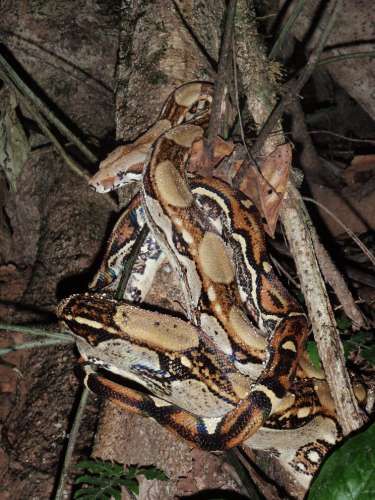


Adults require a minimum floorspace of 4 ft. Babies can be housed in 20-30 gallon enclosures, and juveniles under 3 ft in 30-40 gallons. As previously mentioned, boas grow rather quickly. A heat mat hooked up to a thermostat should instead be used, and cover a third of the floor of the enclosure. Heat lamps are generally not recommend as they make humidity tougher to maintain, and boas tend to instead prefer belly heat for thermoregulating. There is very little data regarding boas and UV lighting, and many owners do not have them installed. Temperature/Lighting/Space Requirements: Your boa requires a heat gradient inside its enclosure with a hot side of ~85 degrees, hot spot of ~90 degrees, and a cooler side in the high 70’s. These snakes can easily live 20+ years with proper husbandry. Length/Lifespan: Female boas are longer on average than males, usually reaching lengths of 6-9 ft. Despite this they are still snakes, and shouldn’t be handled more than 2-3 times a week, and never on a day before or 2-3 days after feeding. These snakes seem to do well with handling, but should be given at least a week to acclimate to their new surroundings. Red-tail boas are considered hardy and have straightforward care, but they’re size, rapid growth, and long lifespan must be considered when purchasing one. Red-tail boas have bred in captivity for years, and as a result have become readily available in a wide range of color morphs. A curious feature of boid snakes is the presence of “pelvic spurs” on either side of their vent, which are believed to be the remnants of hind legs from their ancestors that actually used them. In the wild, they are primarily nocturnal ambush predators, subduing their prey by constriction. The young are independent at birth and will grow rapidly for the first few years, shedding regularly (once every one to two months).Species Info: Red-tail boas are semi-arboreal (tree living), non-venomous snakes from tropical areas of South America. They are still surrounded by the protective membrane and must break it open. When the young are ready to be born, they are pushed out an opening called the cloaca. Some of the young may be still-borns or non-fertilised eggs known as "slugs". The neonates (baby snakes) are born after approximately 100-120 days of development.īoa constrictors are 17-20 inches (43-51 cm) long at birth, and can grow to 3 feet (90 cm) in several months. The female will usually eat little or nothing while she is retaining eggs (called gravid in reptiles). Most clutches number 20-60 thin-membrane eggs. Spurs are remnants of when boas had hind legs they are generally hidden below scales on either side of the vent (genital).īoas are ovo-viviparous, which means the female retains her eggs internally until they hatch, so she will give birth to live, fully formed young. During the rainy season, when they breed and display courtship, males wind back and forth over the female's body, stimulating her cloaca with his spurs. They reach sexual maturity at around 3-4 years of age.


 0 kommentar(er)
0 kommentar(er)
